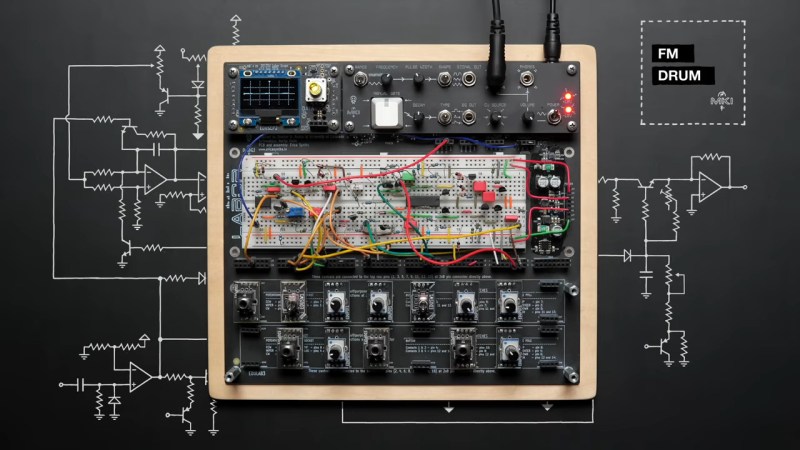How it started: a simple repair job on a Roland drum machine. How it ended: a scratch-built FM drum synth module that’s completely analog, and completely cool.
[Moritz Klein]’s journey down the analog drum machine rabbit hole started with a Roland TR-909, a hybrid drum machine from the mid-80s that combined sampled sounds with analog synthesis. The unit [Moritz] picked up was having trouble with the decay on the kick drum, so he spread out the gloriously detailed schematic and got to work. He breadboarded a few sections of the kick drum circuit to aid troubleshooting, but one thing led to another and he was soon in new territory.
The video below is on the longish side, with the first third or so dedicated to recreating the circuits used to create the 909’s iconic sound, slightly modifying some of them to simplify construction. Like the schematic that started the whole thing, this section of the video is jam-packed with goodness, too much to detail here. But a few of the gems that caught our eye were the voltage-controlled amplifier (VCA) circuit that seems to make appearances in multiple places in the circuit, and the dead-simple wave-shaper circuit, which takes some of the harmonics out of the triangle wave oscillator’s output with just a couple of diodes and some resistors.
Once the 909’s kick and toms section had been breadboarded, [Moritz] turned his attention to adding something Roland hadn’t included: frequency modulation. He did this by adding a second, lower-frequency voltage-controlled oscillator (VCO) and using that to modulate the drum section. That resulted in a weird, metallic sound that can be tuned to imitate anything from a steel drum to a bell. He also added a hi-hat and cymbal section by mixing the square wave outputs on the VCOs through a funky XOR gate made from discrete components and a high-pass filter.
There’s a lot of information packed into this video, and by breaking everything down into small, simple blocks, [Moritz] makes it easy to understand analog synths and the circuits behind them.
















haha it’s a cool project, or it would be if it was documented off of youtube. but i would recommend revising the hackaday style guide to ban ‘from scratch’. the body of the article clearly states the design is derivative. you might call the build ‘from scratch’, but the headline is about the design. misapplying the phrase just provides needless dissonance when trying to parse it.
Click the link to the youtube video, then click the link there to the website and you can find a full manual for the kit that can be purchased.
Then why not give the link to the site directly?
Actually – there is not link to the website. Only to the shop and video.
manual/write-up is available here: https://www.ericasynths.lv/media/FM_DRUM_MANUAL.pdf
I’d be great if there was a [video warning] before the link, I’m really tired of unknowingly spawning YouTube, as specially when I’m reading in bed. The way most articles have been going lately, I guess we should just assume they’re all videos.
I’m assuming you’re not super familiar with instruments, synthesis or specifically analog synthesis in general if you think this is not built from the ground up… in an oversimplification, it’s similar to saying an electric guitar is derivative because it’s not the first electric guitar.
i’m actually super famliar with these things, and i specifically said that it is built from the ground up. perhaps reread my comment thanks
To cook an apple pie from scratch, you must first create the universe
Meh it’s been done universes are nothing new, I would have done it THIS way, clickbait, etc etc
Synth builders ALL rip each other off. It’s an open secret. Many of those copyrights are expired anyways and Behringer has built a whole company off of it. Bob Moog was notoriously terrible at business and copyrighted hardly any of his designs besides the 4-pole filter.
It’s a well known fact that there are not a lot of new designs in analog synthesis and modular synth builders even joke about it (and share their schematics, btw). If you’re going to make that argument, you might as well bitch at people for making Atari Punk Consoles – which themselves are just copies of Forrest Mims’ Stepped Tone Generator from the old Engineer’s Notebooks.
yeah i agree. i mean, the synth i play with every day is a softsynth i wrote ‘from scratch’ but the design is based on a synthesis of what i know as a ‘compilers and languages guy’ and stuff i learned from the excellent book ‘foundations of computer music’ and the other excellent book ‘the scientist and engineers guide to dsp’. accordingly, i would never say my design is ‘from scratch’.
i’m making a pedantic semantic argument about the writing on hackaday. i love derivative works and i would love reading about them even more if the writing didn’t give me cognitive dissonance
The true hack is always in the comments.
For the record, all of Moritz Klein’s videos are fascinating for those wanting to learn how to build audio synthesizers completely from scratch and he even explains some electrical engineering basics if you don’t know a thermistor from a resistor. His more recent videos, since he started selling synth kits, may be a bit more monetized but his early stuff is highly informative and well-researched.